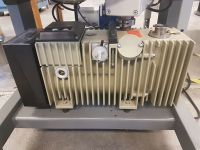Difference between revisions of "Vacuum Pumps"
| Line 12: | Line 12: | ||
=Pfeiffer Rotary Vane Pump UNO/DUO 004B= | =Pfeiffer Rotary Vane Pump UNO/DUO 004B= | ||
[[Image:UNO-DUO004B pump.jpeg|right|Image on right|| 200 px]] | [[Image:UNO-DUO004B pump.jpeg|right|Image on right|| 200 px]] | ||
| − | The manual can be found [http://nuclear.unh.edu/personal_pages/nathaly/UNO-DUO004B_manual.PDF here]. | + | The manual can be found [http://nuclear.unh.edu/personal_pages/nathaly/manuals/UNO-DUO004B_manual.PDF here]. |
Revision as of 16:15, 11 January 2017
Rotary Vacuum Pump G-100D
This rotary pump is located in the Ulvac DLMS-531 Helium leak detector (Blue leak detector). It gets to around 4 mTorr in 2 minutes with a blank and not other vacuum equipment attached. Tested on Jan 10/2017, by keeping 4 mTorr during 30minutes.
Precaution: A sudden stop of the pump may contaminate the vacuum space. Due to, the inlet side of the pump is at negative pressure (-14.7 PSI) and the exhaust is at atmospheric pressure. The atmospheric pressure on the exhaust side of the pump will try and get into where the negative pressure. The oil in the pump is between the inlet and the exhaust. Then, oil molecules will go in to the vacuum space. Therefore, in order to avoid the contamination, bring the system to atmospheric pressure before turning off pump, you may use a valve in the system to vent the pump inlet to atmospheric pressure before stopping pump.
The manual of operation is here.
Pfeiffer Rotary Vane Pump UNO/DUO 004B
The manual can be found here.

